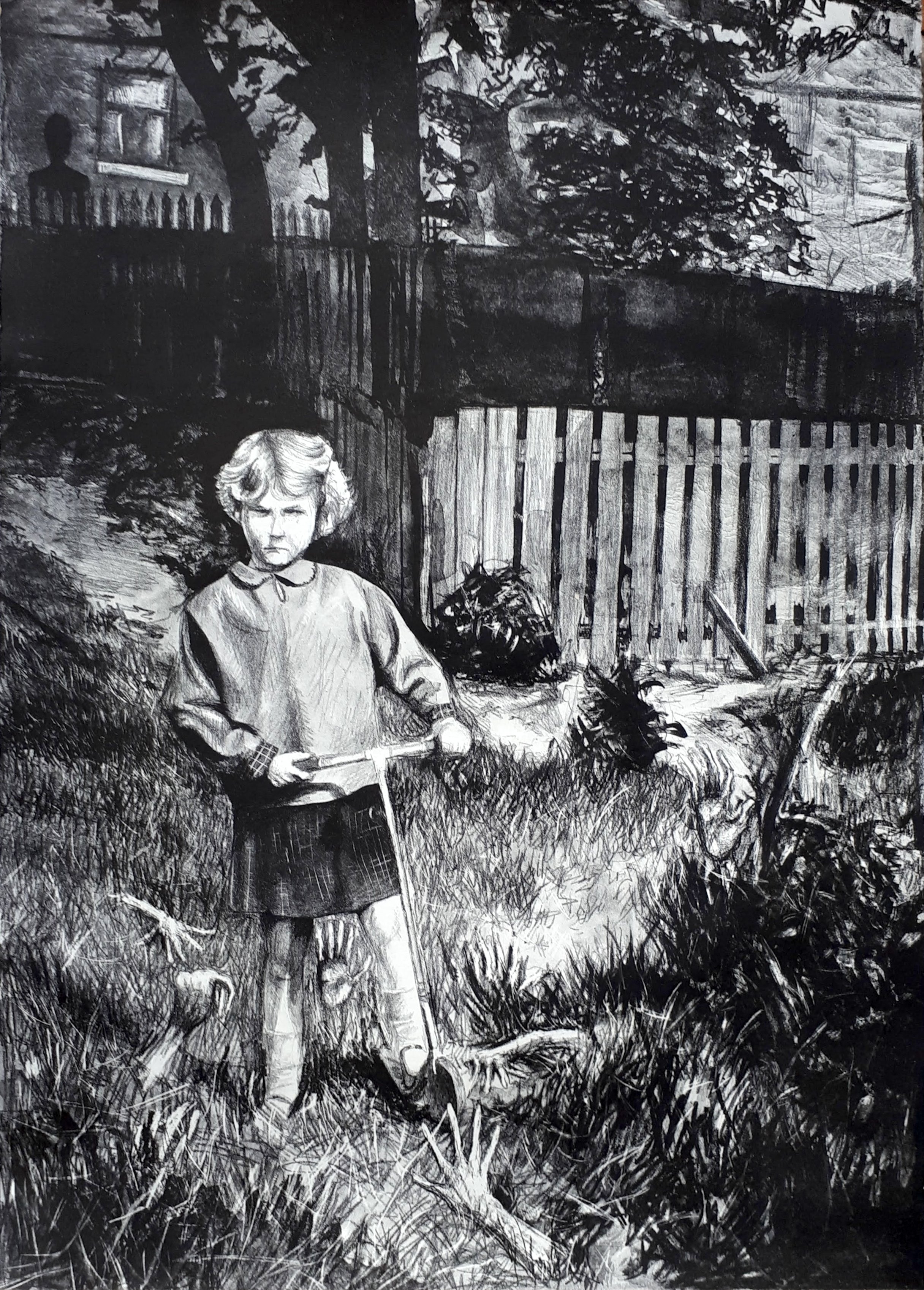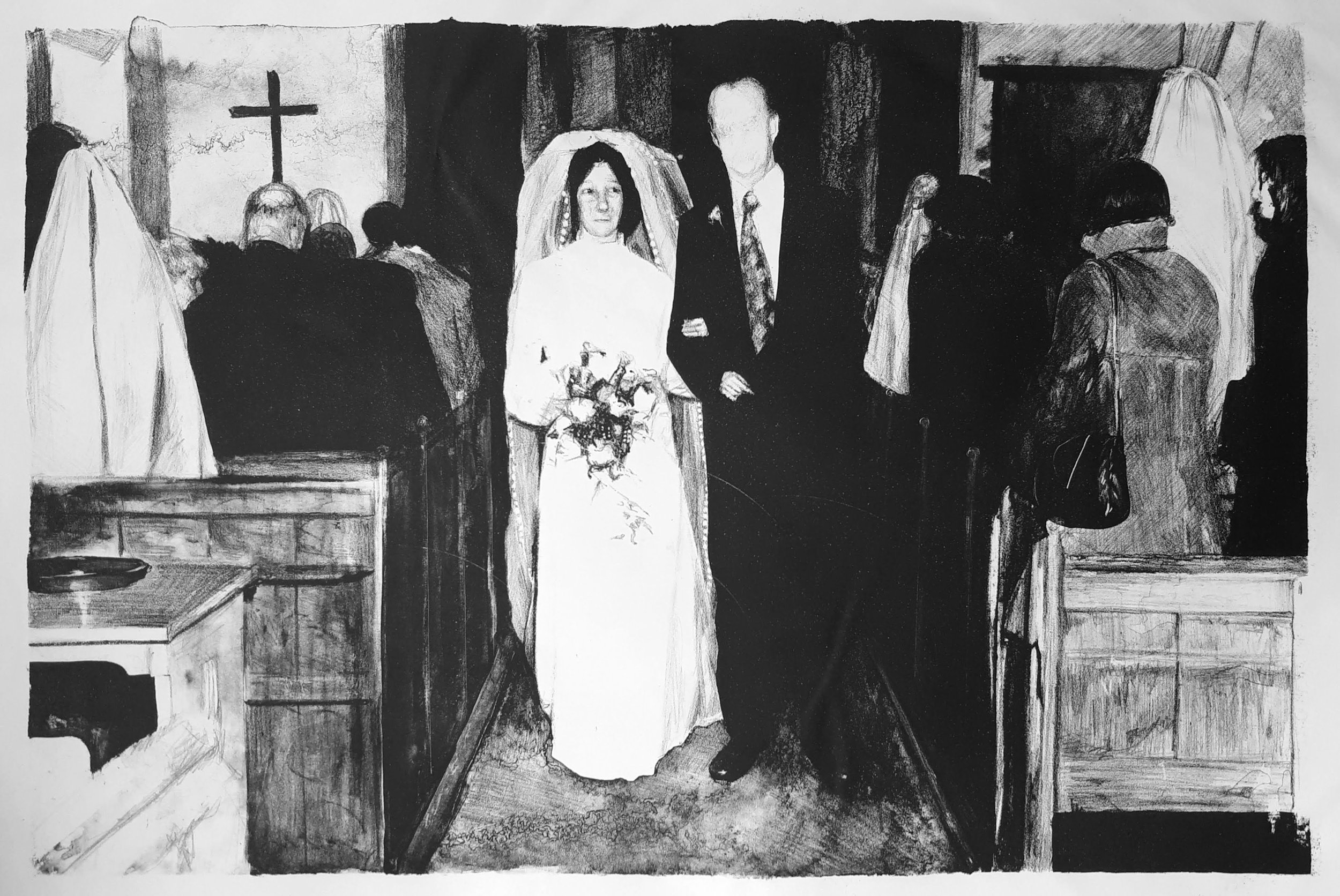ARTIST INTERVIEW: Eve Jansen
Tell me about yourself. What inspired you to become an artist?
I have always had an affinity for the arts. My mother studied art at university, so I was brought up with a lot of creativity and always had projects on the go. It wasn’t really until sixth form that I began to take art seriously. Academically, I excelled; especially in Maths. So, it was a tough decision to take the leap and choose to do something that I had passion for instead. It wasn’t until university that I discovered a love for printmaking, and through that, my work developed to its present form. I can’t say that there was any one point that inspired me to become an artist. It's been a series of ‘well, I’ll see if this works out’, and so far it has.
How does your medium relate to the narrative and mood of your work? What do you find captivating about creating lithographs?
I think lithographs lend themselves incredibly to creating a dark mood. Creating a lithograph is an extremely versatile process - lots of things can go wrong. When I first started creating lithographs, what really captivated me were the reticulated patterns made by the tusche on the stone. There’s something about that texture that makes prints feel almost like they are decaying, and I try to utilise this in as many pieces as I can. I also enjoy that when drawing up the stone, it is both an additive and reductive process. This allows me to create the details in the drawing that wouldn’t be as feasible in any other medium.
Etching and printing the stone is also very laborious and can potentially change the entire feel of the piece. After the first etch, the true nature of the image is revealed and adjustments can be made before it is time to pull prints. There is almost a back and forth with the stone, in order to create the image as you intend. I enjoy this because, to me, each new stone is like a puzzle that needs to be solved, and whilst some aspects of stone lithography aren’t as forgiving, the etching stage is where a piece can really come alive with a bit of tinkering.
How have you encapsulated your love for horror films and your interest in society issues in your work?
I have always adored horror films and often try to utilise imagery from films I have watched in my prints. Many of my prints have hidden figures in the background, which are often missed at a first glance. I got the idea to do this from ‘The Haunting of Hill House’ and ‘Hereditary’, both of which hide characters in the back of scenes without drawing attention to them. I think that this creates a sense of unease when looking at my prints.
As a genre, I think that horror is greatly misunderstood. To me, it isn’t about the jumpscares or the gore. Some of the most poignant movies I have watched have been horror. I believe that horror allows a space to confront fears in a way that is safe, which can in turn reveal things about yourself. Fear is an intrinsic part of human existence and I think it’s important to explore this, especially in the context of society. When covid first hit, I made a collection of drawings. Each one explored new fears that were revealed by covid. As a society we had to quickly change social conventions. We could no longer go near each other, or go outside and this created a lot of anxiety for many people. Many of my prints depict social issues in a similar way.
How do you approach a print? Describe your creative process from the start to finish of a piece.
Usually, a scene will get stuck in my head and I will use this as a starting point. At first, I can’t attribute the image to any particular way I’m feeling until I spend time drawing it out. When the image takes form in my head, I then look through old photographs to find one that will match what I’m picturing. I then do a quick sketch to make sure it works compositionally and then I begin to draw it out properly. I find that as I draw the image, I realise what exactly it means to me, almost like journalling. Sometimes, I base my prints on dreams I have had, like in Reunion. Other times, imagery from films or books inspires me. After the image is drawn out, it can then be etched and printed. This stage is very important as, if not done properly, detail in the print can be lost.
You have expressed that you want to portray things we fear as humans. What thoughts and feelings would you like to evoke from the viewer? Are the fears you suggest ever related to your own personal worries?
When people look at my pieces, I want them to feel unsettled. A lot of my pieces aren’t overly scary, however, I do try to hide little easter eggs in them that not only contribute to the narrative of the piece, but also increase that unsettling feeling. In ‘Keep Off The Grass’ in particular, I wanted the eye to be drawn around the image, starting with the girl, then to the hands hidden in the grass, then finally onto the figure in the background. I think by doing this, I force the viewer to spend time with the piece, and through that, people often draw their own conclusions to what it means. I love to hear what my work means to the viewers because it never aligns with how I view them. People attribute their own fears to my pieces and I find it interesting how differently each one can be interpreted. As I said previously, these pieces are deeply personal to me. If they were put in chronological order, they would form a diary of my anxieties. Some, such as the ones I made at the beginning of lockdown, are based on societal issues, but touch on unique worries I have dealt with. The Wedding, for instance, is related to my asexuality, but I have had people say to me that it reminds me of their own wedding.
Victorian and Edwardian images are the basis of many of your works. What do you find beguiling about these eras? Is there a reason why you use vintage images, rather than pictures taken in this present time?
I think that what first attracted me to these images was how stiff and formal they were. Despite these photos being some of the first truly accurate images we have of people from the past, they are so uncomfortably staged that you don’t really feel any type of connection to them. I think that when I first started using these photos, I wanted to exacerbate that. This sense of disconnection is important to me - I like that I can orchestrate the scene to express myself without feeling too emotionally exposed. I was also interested in using pictures from the past to reflect the present. Because they are so staged, the prints I create almost feel like moments from a play. Modern photographs are often very candid and I didn’t want the pieces to feel too real. I think that they work because they have a dreamlike quality to them that is exacerbated by the antique quality of the images.
Who is your favourite artist? If they were sat next to you right now, what would you ask them? Do they have an influence on your work?
My absolute favourite artist is Jan Švankmajer, a Czech filmmaker. I have been obsessed with his film, ‘Alice’ since childhood. It is a version of Alice in Wonderland that is set in an abandoned warehouse. The creatures Alice encounters are taxidermied animals and he uses stop motion to make many of the scenes in the film come to life. It is incredibly unsettling and one of my first prints was based on the white rabbit in that film. I think that I’m most interested by Švankmajer’s films because of the symbolism in them, so I’d want to know most what these films meant to him and how the metaphors in the films relate to certain topics.
Are you currently working on any new projects? What are your future aspirations as an artist?
I’m currently taking some time to get back into my work. Unfortunately, with the costs associated with lithography, it isn’t feasible for me to use this medium at the moment, so I am focusing on drawing; particularly with fineliners. I’m finding this pleasantly challenging and I hope to exhibit some of these works soon.
Why do you think art is important in society?
Art is so intrinsic to society that I think it is impossible to imagine a world without it. Everything that is created by people has some kind of aesthetic influence. Art is how we truly express ourselves, not just in the traditional sense but in how we dress, how we decorate our homes and how we eat. Of course I’m using the word ‘art’ in the broadest terms here. I believe that art and the ability to create is what makes us human and life would be horribly boring without it.











